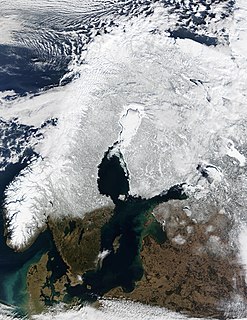
This Viking Age runestone, listed under Rundata as runic inscription U 489, was originally located in Morby, Uppland, Sweden, and is a memorial to a woman.
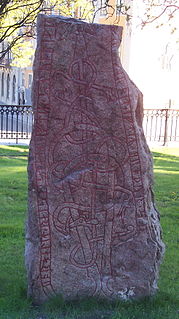
Uppland Runic Inscription 933 or U 933 is the Rundata catalog number for a granite Viking Age memorial runestone located at the Uppsala Cathedral, which is in the center of Uppsala, Sweden.
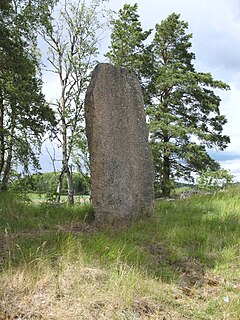
The Gällsta Runestones from the 11th century commemorate four generations of the same family in Viking Age Sweden. There are three runestones and a raised stone which is only inscribed with a cross. The runestones are located at the northern outskirts of Stockholm, just northwest of the lake Vallentunasjön, around which is found the world's greatest concentration of runestones. All the Gällsta Runestones are attributed to Öpir, the most productive of all the old runemasters.
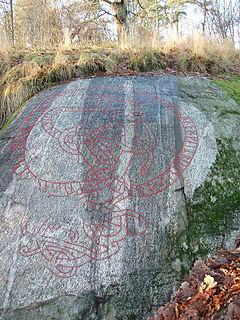
Runic inscription U Fv1986;84 is the Rundata catalog number for a Viking Age memorial that is located at Bo gård on the island of Lidingö in Uppland, Sweden.

Uppland Runic Inscription 1034 or U 1034 is the Rundata catalog number for a runic inscription on a runestone located at the Tensta Church, which is three kilometers northwest of Vattholma, Uppsala County, Sweden, and in the historic province of Uppland, that was carved in the late 11th or early 12th century. While the tradition of carving inscriptions into boulders began in the 4th century and lasted into the 12th century, most runestones date from the late Viking Age.

Uppland Runic Inscription 308 or U 308 is the Rundata catalog designation for a memorial runestone that is located in Ekeby, Stockholm County, Sweden, which was in the historic province of Uppland. While the tradition of carving inscriptions into boulders began in the 4th century and lasted into the 12th century, most runestones date from the late Viking Age.

This runic inscription, designated as U Fv1948;168 in the Rundata catalog, is on a Viking Age memorial runestone to two sons that is located in Alsike, Uppsala County, Sweden, which is in the historic province of Uppland.

This runic inscription, designated as U Fv1976;104 in the Rundata catalog, is on a Viking Age memorial runestone that is located at the Uppsala Cathedral, Uppland, Sweden.

The Björklinge runestones are five Viking Age memorial runestones designated in the Rundata catalog as U 1045, U 1046, U 1047, U 1048, and U 1050 that are located at the church in Björklinge, Uppsala County, Sweden, which is in the historic province of Uppland. In addition, there is a small fragment of a runestone with a partial runic text i * lit * rita * meaning "had erected" that has been given the catalog number U 1049.
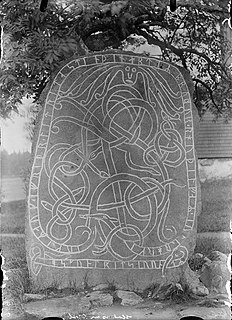
Uppland Runic Inscription 824 is the Rundata catalog number for a Viking Age memorial runestone located at Holms, which is about eight kilometers east of Örsundsbro, Uppsala County, Sweden, and in the historic province of Uppland. The inscription features a facial mask and a bind rune in the text.

Uppland Runic Inscription 993 or U 993 is the Rundata catalog number for a Viking Age memorial runestone located in Brunnby, which is one kilometer west of Gunsta, Uppsala County, Sweden, which was part of the historical province of Uppland.
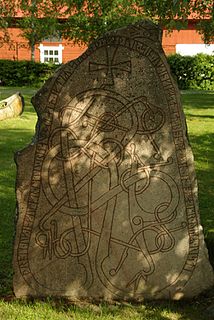
Uppland Runic Inscription 485 or U 485 is the Rundata catalog number for a Viking Age memorial runestone that is located in Marma, which is about six kilometers northeast of Knivsta, Uppsala County, Sweden, which was in the historic province of Uppland.

Uppland Runic Inscription Fv1953;263 or U Fv1953;263 is the Rundata catalog listing for a Viking Age memorial runestone that was discovered at Helenelund, which is in Sollentuna, Stockholm County, Sweden, which was in the historic province of Uppland.
Uppland Runic Inscription 896 or U 896 is the Rundata catalog listing for a Viking Age memorial runestone originally located at Håga in the historic province of Uppland, Sweden, but is now at the Universitetsparken of Uppsala University.
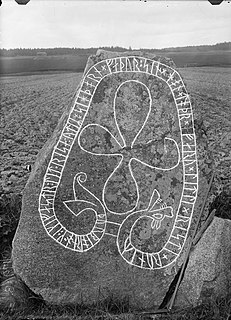
The Grällsta Runestone, listed as Västmanland Runic Inscription 27 or Vs 27 in the Rundata catalog, is a Viking Age memorial runestone located in Grällsta, which is about nine kilometers northeast of Ransta, Västmanland County, Sweden, which was in the historic province of Västmanland. A second runestone that has been designated as Västmanland Runic Inscription 28 or Vs 28 was once located in Grällsta, but it is now considered to be lost.

Uppland Runic Inscription 171 or U 171 is the Rundata catalog listing for a Viking Age memorial runestone that is located in Söderby, which is four kilometers west of Vaxholm, Stockholm County, Sweden, and in the historic province of Uppland.
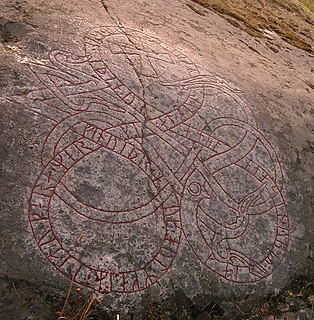
Uppland Runic Inscription 210 or U 210 is the Rundata catalog listing for a Viking Age memorial runic inscription which is carved on a rock-face that is located in Åsta, which is three kilometers east of Vallentuna, Stockholm County, Sweden, and in the historic province of Uppland. The inscription is signed by the runemaster Öpir.

Uppland Runic Inscription 541 or U 541 is the Rundata catalog listing for a Viking Age memorial runestone which is located at the Husby-Sjuhundra church, which is five kilometers west of Norrtälje, Stockholm County, Sweden, and in the historic province of Uppland. The inscription is signed by the runemaster Öpir.

The Bolsta Runestones are two Viking Age memorial runestones and two fragments of a third that are located in Bolsta, which is on the east edge of Uppsala, Uppsala County, Sweden, and in the historic province of Uppland. One runestone is signed by the runemaster with the normalized name of Åsmund Kåresson and the other by the runemaster named Öpir.

